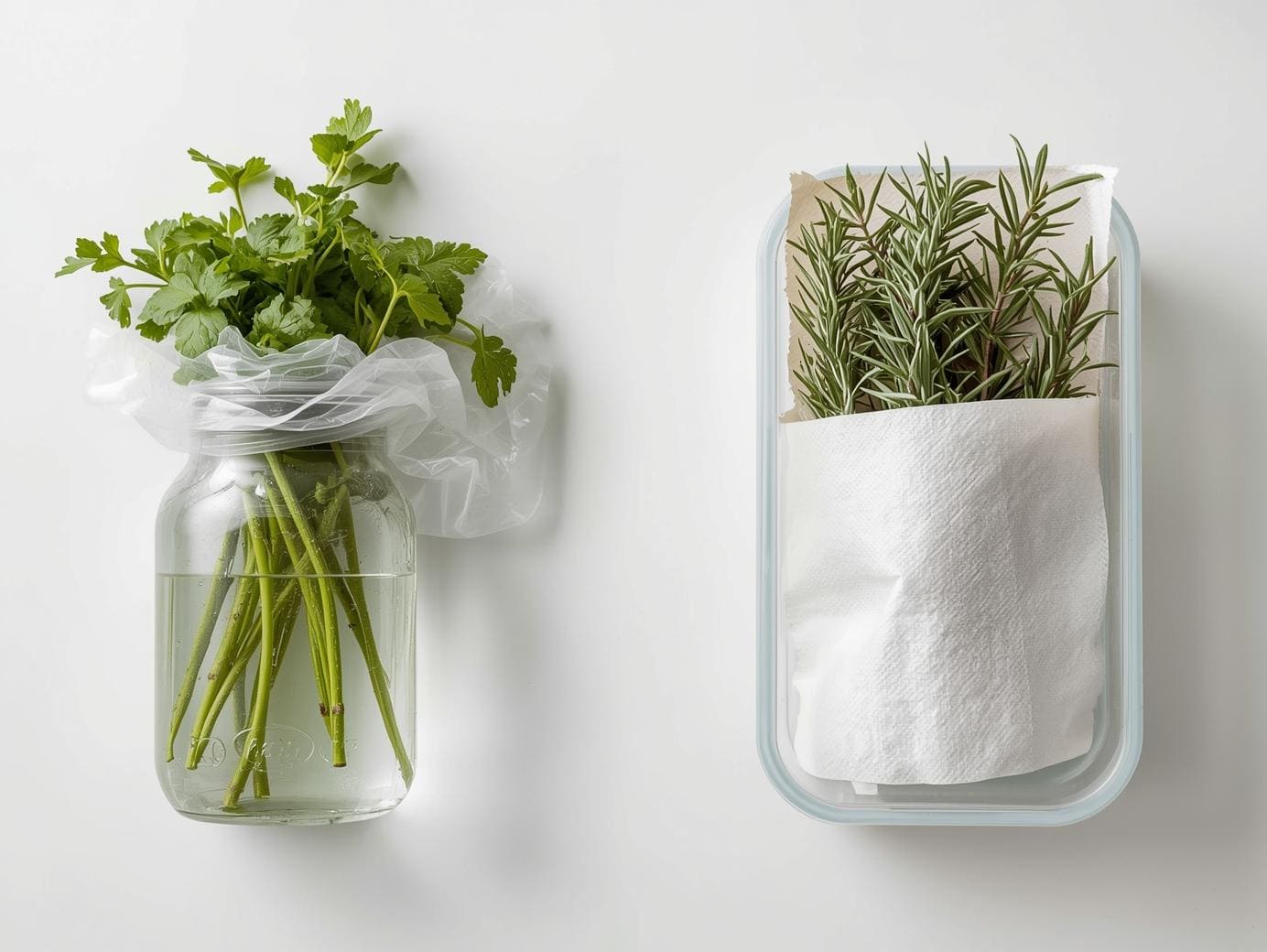Fresh herbs are the lifeblood of great cooking, adding a burst of flavour and aroma that dried herbs simply can’t match. However, the joy of a new bunch of mint or basil is often short-lived. Far too often, we find them wilted, brown, or slimy just a couple of days after purchase.
The secret to making your herbs last for weeks—not days—lies in understanding their basic nature. Different herbs require different methods of hydration and protection.
Stop throwing away money on wasted produce! This guide breaks down the simple, proven methods used by professional chefs to maximize the shelf life of every herb, starting with the crucial distinction between Hard Herbs and Soft Herbs.
Section 1: The Golden Rule – Hard Herbs vs. Soft Herbs
All fresh herbs fall into one of two categories, and your storage method must match the category.
Soft Herbs (The “Flowers” – Need Moisture)
These herbs have tender stems and large, delicate leaves. They thrive when their stems are placed in water, similar to cut flowers.
| Soft Herbs Example | Best Storage Placement |
| Basil | Countertop (in water) |
| Cilantro | Refrigerator (in water) |
| Parsley | Refrigerator (in water) |
| Mint | Refrigerator (in water) |
Hard Herbs (The “Woody Ones” – Need Air Circulation)
These herbs have woody, tough stems and small, sturdy leaves. They are resilient but need to be protected from drying out.
| Hard Herbs Example | Best Storage Placement |
| Rosemary | Refrigerator (in damp paper towel) |
| Thyme | Refrigerator (in damp paper towel) |
| Oregano | Refrigerator (in damp paper towel) |
| Dill | Refrigerator (in damp paper towel) |
Section 2: Step-by-Step Storage Techniques
Follow these simple, effective steps based on the type of herb you have.
Technique A: The “Flower Bouquet” Method (For Soft Herbs)
This method rehydrates the herbs continuously, prolonging their life and vibrancy.
- Trim the Stems: Cut about half an inch off the bottom of the stems, much like you would with flowers.
- Place in Water: Fill a small jar or glass with about an inch of clean, cold water. Place the herbs (stem-side down) into the water.
- Cover: Loosely cover the leaves with a plastic bag (the bag the herbs came in works well). This acts like a mini-greenhouse, trapping moisture and humidity.
- Placement: Basil must stay on the countertop, away from direct sunlight. All other soft herbs (Cilantro, Parsley, Mint) belong in the refrigerator. Change the water every few days.
Technique B: The “Burrito Roll” Method (For Hard Herbs)
Hard herbs are prone to getting slimy if they are completely submerged or too dry if left exposed.
- Dampen: Lightly dampen a few paper towels. They should be moist, not soaking wet.
- Wrap: Lay the herbs flat on the damp paper towel and roll them up gently, like a burrito.
- Seal: Place the rolled herbs inside a sealed zip-top bag or an airtight container.
- Refrigerate: Store the container in the crisper drawer of your refrigerator. The damp towel provides just enough moisture without causing rot.
Section 3: Advanced Storage: Freezing for Long-Term Use
If you have a large excess of herbs or know you won’t use them within a few weeks, freezing is the best way to lock in their flavour for future cooking.
The Ice Cube Tray Method (Best for Cooked Dishes)
This method works for any herb (both soft and hard) that will be used in soups, stews, or sauces.
- Chop: Finely chop the fresh herbs (e.g., rosemary, basil, or cilantro).
- Fill the Tray: Place a spoonful of the chopped herbs into each cube section of an ice cube tray.
- Add Oil: Top the herbs with olive oil (or melted butter). The fat acts as a preservative and flavour enhancer.
- Freeze and Store: Freeze solid, then pop the frozen herb cubes out and store them in a large freezer-safe bag or container.
- Usage: When cooking, simply toss a cube directly into your hot pan or pot. One cube usually equals about one tablespoon of fresh herb flavour.
Conclusion
The small effort of properly storing your fresh herbs yields massive results—both in your budget and your cooking quality. By simply respecting whether your herb is a “flower” or a “wood,” you can ensure that the beautiful, vibrant flavours you buy today are ready to enhance your meals for weeks to come. Say goodbye to wilting waste and hello to always-fresh flavour!


Leave a Reply